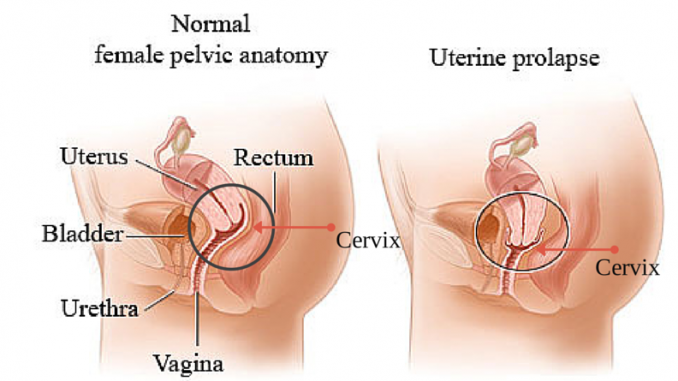
Uterine Prolapse is the downward displacement of any pelvic organ from its normal position. It usually involves the uterus and along with it bladder or rectum may also be involved. Complete Pelvic organ Prolapse is known as Procidentia.
Uterine Prolapse is most often attributed to childbirth injury or it may be due to inherent weakness of suspensary ligaments. Prolapse manifests most commonly after Menopause when the production of ovarian hormones gradually stops and genital support weakens.
Common Symptoms:
- Feeling of a lump coming out of the vaginal orifice
- Dragging sensation in the pelvis, especially at end of day
- Backache
- Difficulty in walking
- Difficulty in intercourse
- Concomitant stress incontinence or frequency, inadequate emptying of bladder and repeated
- Urinary tract infection
- Difficulty in defecation and constipation
Causes
Pelvic organ prolapsed is usually caused by damage to the tissues(muscles, ligaments and connective tissue) that support the pelvic organs. Damage or stretching of these tissues allows the organs to move out of their normal positions. This causes them to press against(and sometimes move) the inside walls of the vagina.
Having a baby makes it more likely that you will have pelvic organ prolapsed later Vaginal childbirth has been strongly linked to weakened and stretched support structures in the pelvic area. This loss of support is the biggest cause of pelvic organ prolapsed. Having a caesarean section seems to be less strongly linked to pelvic organ prolapsed.
Another cause of reduced support in the pelvis is lower levels of hormone estrogen. Estrogen levels are lower during and after menopause. The lower levels of estrogen in the body mean less collagen, a protein that helps the pelvic connective tissues stretch and return to their normal positions.
Other things that may increase the risk of pelvic organ prolapsed include:
- Women who are overweight have increased pressure in the abdomen and have a higher rate of pelvic organ prolapsed.
- Smoking and lung conditions that cause chronic coughing, which increases pressure in the abdomen and pelvis.
- Chronic constipation causes increased pressure from the bowel on the vaginal wall.
- Certain occupations that require heavy lifting.
- Pelvic surgery, such as removal of the uterus (hysterectomy). This may damage support for a pelvic organ, which can result in movement of one or more organs within the pelvis.
- Diseases of the nervous system. Pelvic organ prolapsed is more common in women who have multiple sclerosis, muscular dystrophy, or a spinal cord injury than in women who do not have such conditions.
- Genetic factors: A weakness in the supportive tissue of the pelvis can be passed through families. If your mother or sister has had pelvic organ prolapsed, you may be more likely to get it too.
Treatment Options
Expectant Management: Uterine Prolapse may be discovered during a routine gynaecological examination. Such patients may not have any symptoms. They are advised for buttock squeezing exercises or Kegel exercises. In post-Menopausal women, use of estrogen cream may also help to strengthen the support.
Surgical Management: The nature of Uterine Prolapse surgery depends on the degree and type of uterine prolapse; and the need for preservation of menstrual, reproductive or coital function. The operation can be done vaginally, abdominally or laparoscopically.
Vaginal Hysterectomy and Repair: Uterine prolapsed is generally treated by Vaginal Hysterectomy and repair. It is preferred in a women who has completed her family as desired and is not particular about preserving her menstrual function. The advantage is that both anterior and posterior repairs can be done in the same sitting without separate incisions or repositioning the patient. Vaginal
Hysterectomy is usually sufficient for those with Grade1-2 prolapse, who want to remove the uterus. It is a fast and safe procedure, with good recovery in short time, and provides the advantage of being scarless at the same time.
Sacrospinous Fixation: This is done for Procidentia (Grade 3-4 Uterine Prolapse/Complete Uterine Prolapse), which needs extra support together with Vaginal Hysterectomy to prevent vault prolapse in future; a highly specialized procedure which involves suturing the remaining vagina to deep-seated Sacrospinous ligament of Pelvis. This procedure is also done for Recurrences where the vaginal skin everts out after a previous Vaginal Hysterectomy. The challenging and difficult cases can be easily managed by efficient dissection of right planes during Sacrospinous Fixation.
Manchester/Fothergill Repair: This is an alternative for patients with prolapsed who wish to retain the uterus but have completed the family. Uterus is pushed up and tightened inside the vagina. It allows good relief of symptoms.
Utero/Cervicopexy & Sling Operation: Occasionally Marked Uterine Prolapse may develop in a young patient due to inherent weakness of suspensory supports. The basic principle behind these operations is to fortify the supporting Ligamentary Structures. Either natural body tissue may be used such as Rectus Sheath or artificial material such as Mersilene/Nylon tapes may be used. This operation is possible through Laparpscopy. These are used in patients who are keen on future fertility.
